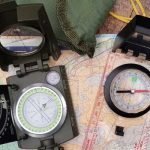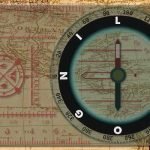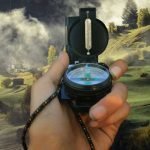Learning to navigate using a compass is much more than knowing how to take a bearing or set up declination. Before getting started with the whole process of navigation, you need to get acquainted with the anatomy of a compass and learn all of the nooks and crannies of this useful tool.
True North vs Magnetic North in Relation to a Compass’ Composition
Before taking a look at the parts of a compass, there is something important that needs to be acknowledged, and that is the fact that there are two norths: magnetic north and true north.
All compasses have to be set up to guide you towards magnetic north, which points to the earth’s natural magnetic pull. The earth’s magnetic pull changes constantly and varies every year, which is why maps have to be updated constantly with the new degree of declination in an area.
True north points towards the north pole and unlike magnetic north, it never changes. Gyrocompasses are the only types of compasses that actually point towards true north because they are not magnetic.
All professional compasses will have parts that will point towards both norths to help you orient yourself in an accurate manner.
Essential Parts of a Compass
The parts that will be a part of your compass’ anatomy will depend on the type of compass you have. While there are many different types of compasses, the most common one that is used is the baseplate compass.
Rotating Bezel
The rotating bezel is the big circle that marks the degrees clockwise from 0 up to 360. Some also call the bezel a dial or compass housing.
Index Line
A marker that is found above the bezel. This marker is normally accompanied by an empty space where the index line fits right in the middle. The index line marks the place where you will read your bearings.
Magnetized Needle
The needle always points to the magnetic north pole, not the true north pole.
Orienting Arrow
Inside of the bezel, along with the magnetized needle, you will find a big arrow that is used to orient the bezel.
Orienting Lines
Alongside the orienting arrow you will find orienting lines. These lines are normally used to help you line up the compass with north on a map.
Declination Scale
Some compasses have a declination scale, which is normally found inside of the bezel. This is a helpful scale that helps you to ease and adjust declination.
Baseplate
A clear plastic covering that is used to place on top of a map: it’s see-through so you can see the map below it while you take a bearing. The baseplate has rulers on the side to use along with the map scale to calculate distance.
Direction of Travel Arrow
On the top of the baseplate along the shorter straight side, you will find a direction of travel arrow that reminds you which direction to take when you take a bearing.
Practice Makes Perfect
While it may seem like there are too many components to a compass, you will find that they are all useful, necessary and essential to learn how to navigate. Every single little nook and cranny has a specific purpose that will help you find your way.
If you would like to learn how to use a compass, check out our article about how to use a compass, where you will be guided step by step on how to set declination and how to take a bearing.




